Key takeaways:
- Gender equality requires a transformation in societal mindset, encompassing more than just equal pay and job opportunities.
- Effective gender policies must be inclusive, data-driven, and supported by ongoing training to ensure lasting impact.
- Historical movements for women’s rights have shaped the discourse on gender equality, highlighting the importance of intersectionality in advocacy.
- Challenges such as societal resistance, lack of comprehensive data, and insufficient political will persist in the development of gender policy.
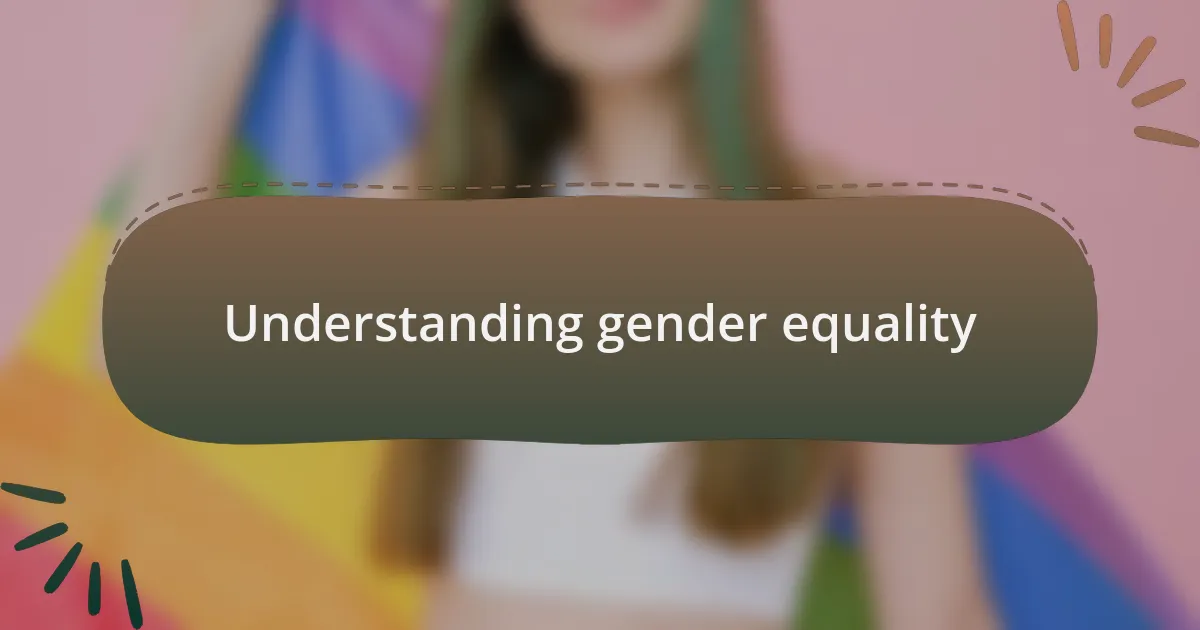
Understanding gender equality
Gender equality is a fundamental human right that recognizes the intrinsic worth of all individuals, regardless of gender. I often think about a time when I witnessed a friend being overlooked for a promotion simply because of her gender. It was disheartening, and it made me realize how deep-rooted biases can stifle talent and potential.
When we discuss gender equality, it’s essential to understand that it goes beyond just equal pay or job opportunities. Have you ever paused to consider how social norms shape our perceptions of gender roles? From childhood, we’re often conditioned to accept certain stereotypes, which can limit our understanding of each other’s capabilities and aspirations.
As I reflect on my experiences, I realize that achieving true gender equality requires a shift in mindset and behavior at every level of society. For instance, I remember a powerful workshop I attended, where participants shared personal stories of overcoming gender-related challenges. This collective sharing not only fostered empathy but also highlighted the urgent need for inclusive policies that empower everyone, regardless of gender.
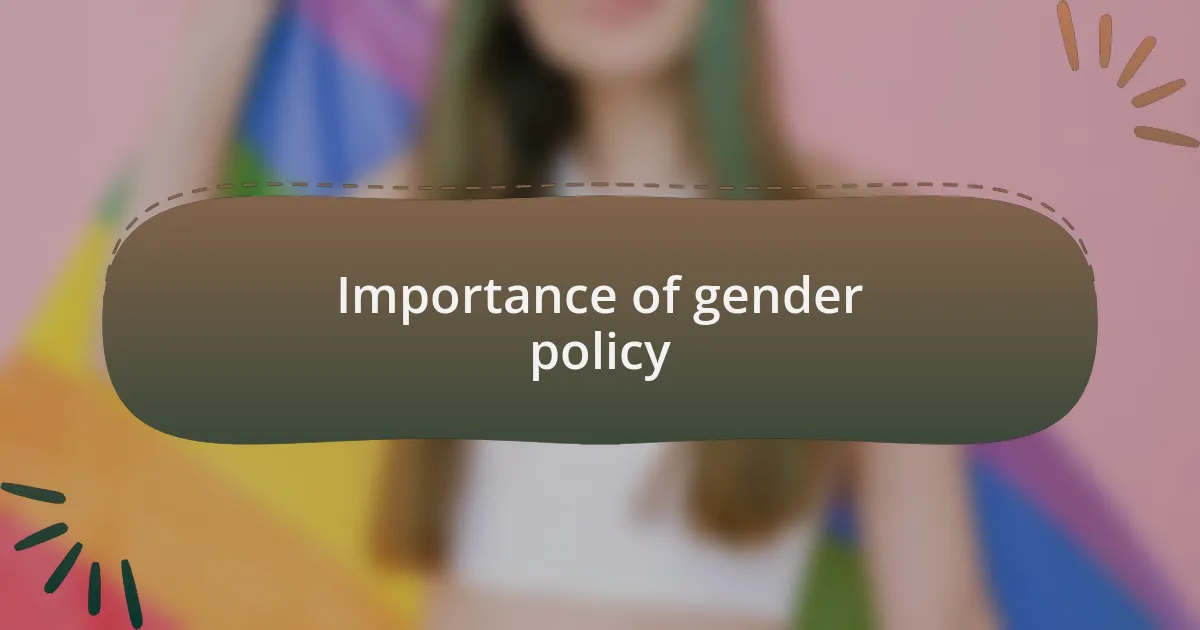
Importance of gender policy
Effective gender policy is crucial because it serves as a framework for eliminating discrimination and fostering inclusivity. I remember attending a community meeting where the local government discussed implementing policies aimed at supporting working parents, especially mothers. Listening to parents share their challenges made it clear to me that good policies can significantly enhance not only workplace environments but also family dynamics.
When policies are thoughtfully designed, they can empower individuals by providing equitable access to resources and opportunities. I often wonder how many talented individuals have been sidelined due to a lack of supportive mechanisms in place. One of my friends, a single mother, shared how a flexible work policy allowed her to pursue further education while raising her child. This change didn’t just benefit her; it inspired an entire group of colleagues to advocate for similar policies within their own workplaces.
Moreover, gender policy is not a one-size-fits-all solution but rather a tailored approach that acknowledges diverse experiences. I find it inspirational when organizations actively seek feedback from those affected by their policies. For instance, a nonprofit I worked with once hosted open forums to hear firsthand from individuals about their unique struggles. This level of engagement demonstrated that when we prioritize dialogue, we contribute to a more equitable society where all voices are heard.
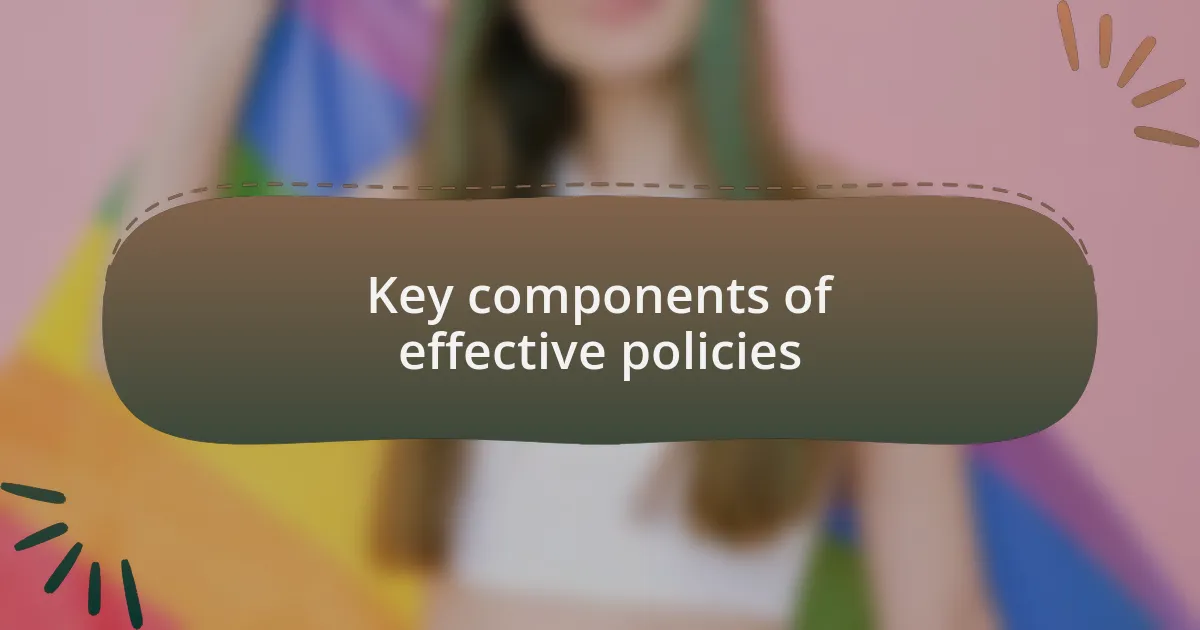
Key components of effective policies
When I think about effective gender policies, one key component stands out: inclusivity. I recall a workshop where an organization reviewed its policies, striving to include perspectives from all genders, abilities, and backgrounds. This openness led to richer discussions and a plan with greater potential to address the real needs of the community. It made me realize that we cannot assume we know what works without actively seeking input from those directly impacted.
Another crucial element is data-driven decision-making. I often reflect on a case where a community used local statistics to identify gender disparities in job promotions. They developed targeted programs that aimed at breaking down those barriers. The change that followed was palpable, as underrepresented groups began to see more representation in leadership roles. Isn’t it fascinating how numbers can illuminate hidden challenges that often go unnoticed?
Lastly, ongoing training and awareness initiatives are essential for sustaining policy effectiveness. I remember participating in a diversity training session that really opened my eyes to my own biases. When organizations invest in educating their employees, they foster an environment where everyone understands the importance of equality. This commitment to learning cultivates a more respectful workplace culture, ultimately enriching the overall environment for everyone involved.
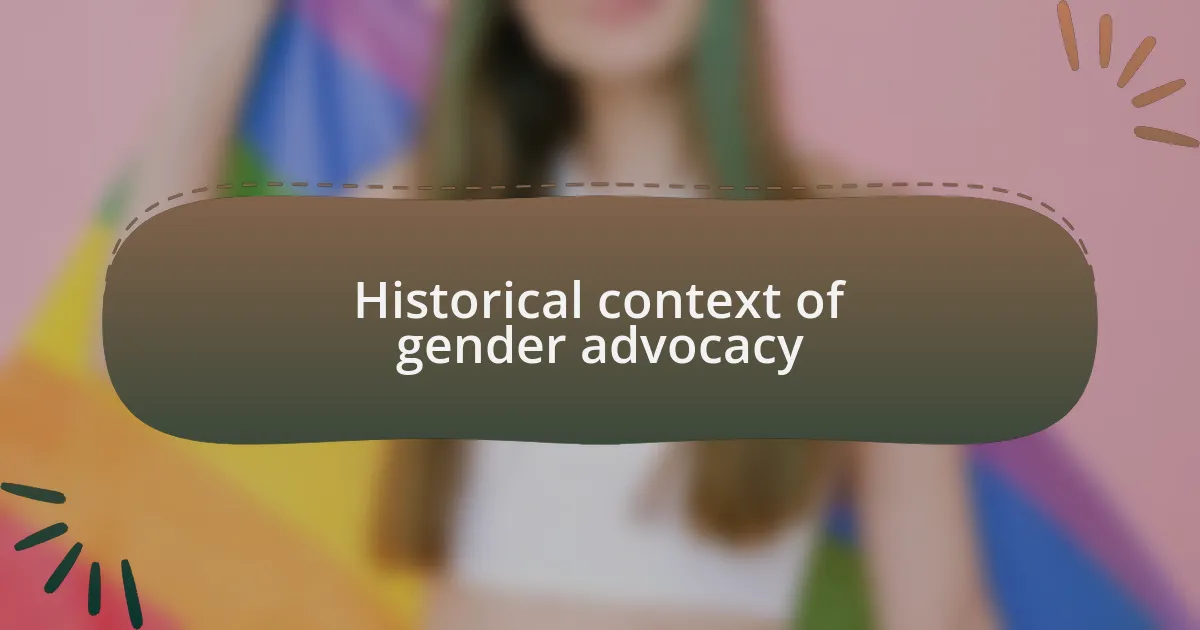
Historical context of gender advocacy
Reflecting on the historical context of gender advocacy, I often think about the suffragette movement in the early 20th century. It’s remarkable to see how passionate activists fought tirelessly for women’s right to vote, often facing severe backlash and societal ridicule. Witnessing their determination reminds me that progress is rarely linear and that each victory must be fiercely defended.
As the decades rolled on, the feminist movements of the 1960s and 70s reshaped the discourse surrounding gender equality. I remember reading about the waves of protests and the establishment of pivotal policies that sought to dismantle systemic inequalities. It struck me how interconnected these movements were with other civil rights struggles, emphasizing that gender advocacy cannot exist in a vacuum.
Then there’s the evolution of understanding intersectionality, which emerged from earlier feminist talks but grew into a broader recognition of how various identities interact. Sometimes, when I ponder the term “intersectionality,” I consider how overlapping social identities might affect an individual’s experience with gender policies. Have we truly grasped the complexities of this concept? I believe we are still learning to incorporate these layers into our advocacy efforts, continually adjusting our approach to be truly inclusive.
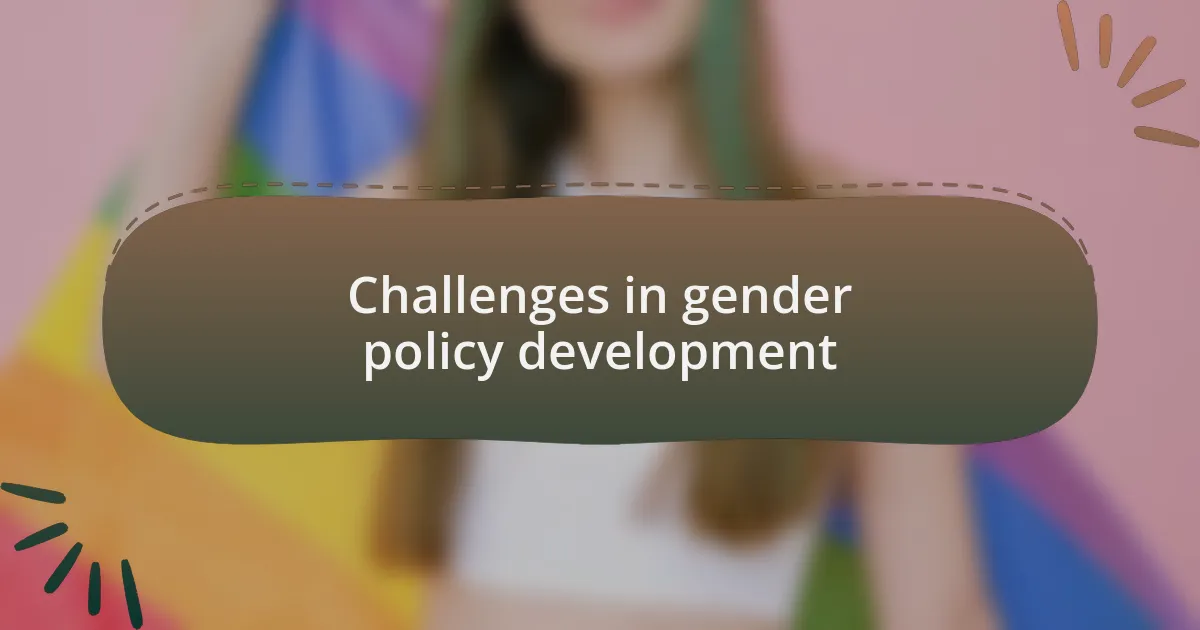
Challenges in gender policy development
When delving into the challenges of gender policy development, one of the most significant hurdles I’ve observed is the resistance from entrenched societal norms. It often baffles me how tradition can overshadow the very real needs of individuals. For instance, I remember collaborating on a local initiative aimed at implementing gender-inclusive policies, only to encounter pushback rooted in outdated beliefs. It makes me wonder: how can we shift these perspectives to place people’s rights at the forefront?
Another challenge is the lack of comprehensive data to inform policy decisions effectively. Data collection often neglects marginalized voices, which leads to policies that don’t accurately reflect the diverse realities of gender identities. I once facilitated a workshop where participants shared their personal experiences, shedding light on the inadequacies of existing data. Such moments remind me that without a robust understanding of community needs, we risk creating policies that are well-intentioned but ultimately ineffective.
Lastly, there’s the ongoing issue of political will, or rather, the absence of it. I’ve witnessed many promising initiatives fail to gain traction because policymakers prioritize short-term gains over long-term solutions. It’s a frustration I carry with me, as I believe genuine commitment to gender equality must come from the top. How can we encourage our leaders to embrace this responsibility? It’s a question that lingers in my mind and drives my advocacy work forward.
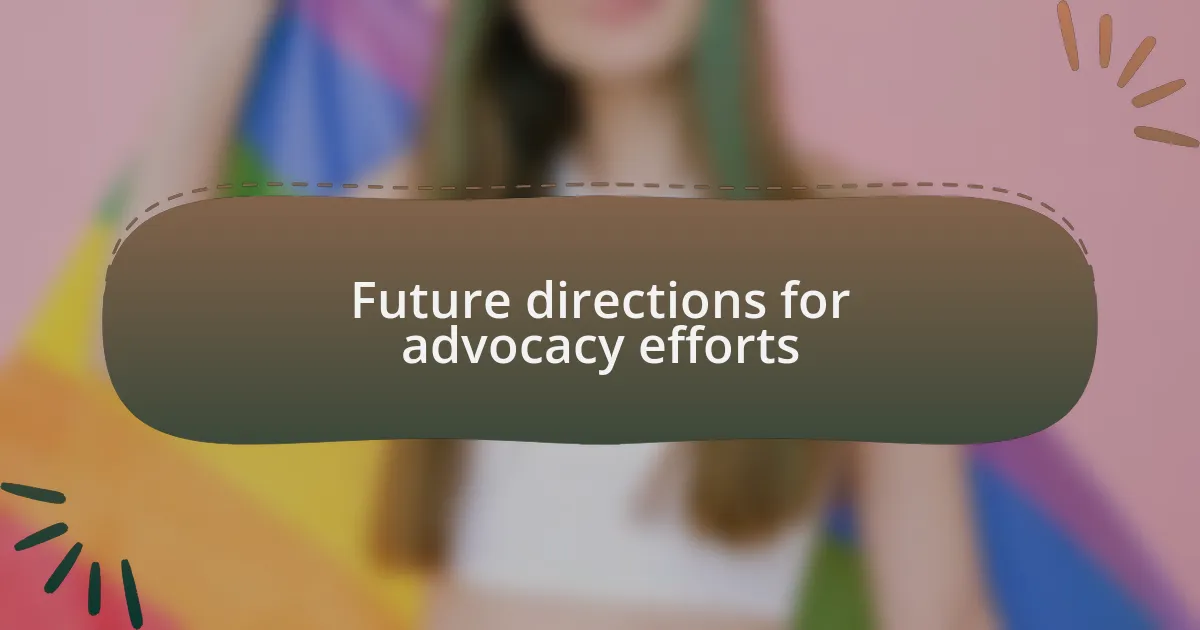
Future directions for advocacy efforts
Thinking about future directions for advocacy efforts, I believe fostering intersectionality in our approach is vital. For example, during a recent conference, I was moved by a speaker who shared how different identities intersect to shape individual experiences. It hit home for me—how can we advocate for policies that truly support everyone if we overlook these crucial intersections?
We must also prioritize grassroots movements. I recall a community gathering where individuals shared powerful stories of their struggles and triumphs. These conversations are the backbone of advocacy; they remind me that real change comes from the ground up. How can we amplify these voices so they resonate more widely in policy discussions?
Lastly, leveraging technology and social media must be part of our strategy. I’ve seen firsthand how a single tweet can spark a conversation that leads to substantial change. Aren’t we missing an opportunity if we don’t harness these platforms to advocate for gender equality? It’s a thought that keeps me engaged in this work, energizing my commitment to using every tool available.